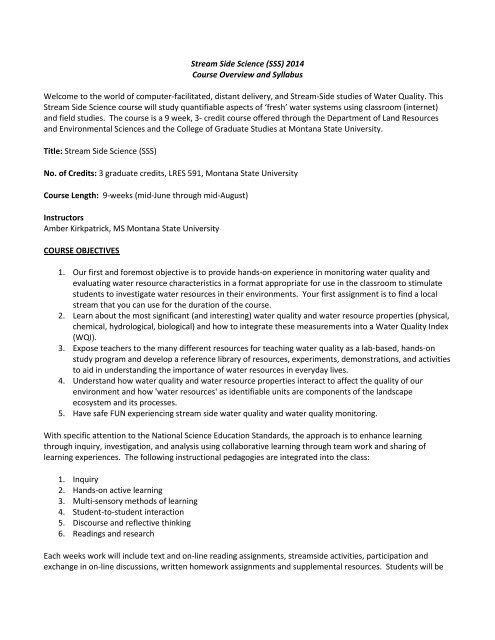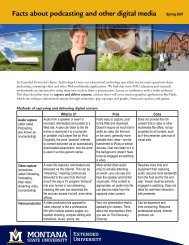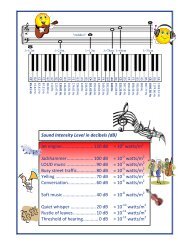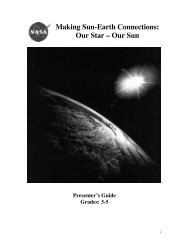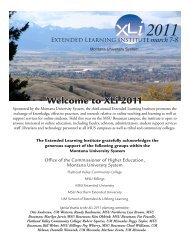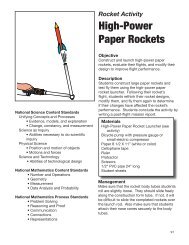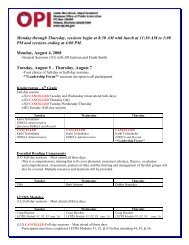Course Overview and Syllabus - Extended University - Montana ...
Course Overview and Syllabus - Extended University - Montana ...
Course Overview and Syllabus - Extended University - Montana ...
Create successful ePaper yourself
Turn your PDF publications into a flip-book with our unique Google optimized e-Paper software.
Stream Side Science (SSS) 2014<br />
<strong>Course</strong> <strong>Overview</strong> <strong>and</strong> <strong>Syllabus</strong><br />
Welcome to the world of computer-facilitated, distant delivery, <strong>and</strong> Stream-Side studies of Water Quality. This<br />
Stream Side Science course will study quantifiable aspects of ‘fresh’ water systems using classroom (internet)<br />
<strong>and</strong> field studies. The course is a 9 week, 3- credit course offered through the Department of L<strong>and</strong> Resources<br />
<strong>and</strong> Environmental Sciences <strong>and</strong> the College of Graduate Studies at <strong>Montana</strong> State <strong>University</strong>.<br />
Title: Stream Side Science (SSS)<br />
No. of Credits: 3 graduate credits, LRES 591, <strong>Montana</strong> State <strong>University</strong><br />
<strong>Course</strong> Length: 9-weeks (mid-June through mid-August)<br />
Instructors<br />
Amber Kirkpatrick, MS <strong>Montana</strong> State <strong>University</strong><br />
COURSE OBJECTIVES<br />
1. Our first <strong>and</strong> foremost objective is to provide h<strong>and</strong>s-on experience in monitoring water quality <strong>and</strong><br />
evaluating water resource characteristics in a format appropriate for use in the classroom to stimulate<br />
students to investigate water resources in their environments. Your first assignment is to find a local<br />
stream that you can use for the duration of the course.<br />
2. Learn about the most significant (<strong>and</strong> interesting) water quality <strong>and</strong> water resource properties (physical,<br />
chemical, hydrological, biological) <strong>and</strong> how to integrate these measurements into a Water Quality Index<br />
(WQI).<br />
3. Expose teachers to the many different resources for teaching water quality as a lab-based, h<strong>and</strong>s-on<br />
study program <strong>and</strong> develop a reference library of resources, experiments, demonstrations, <strong>and</strong> activities<br />
to aid in underst<strong>and</strong>ing the importance of water resources in everyday lives.<br />
4. Underst<strong>and</strong> how water quality <strong>and</strong> water resource properties interact to affect the quality of our<br />
environment <strong>and</strong> how 'water resources' as identifiable units are components of the l<strong>and</strong>scape<br />
ecosystem <strong>and</strong> its processes.<br />
5. Have safe FUN experiencing stream side water quality <strong>and</strong> water quality monitoring.<br />
With specific attention to the National Science Education St<strong>and</strong>ards, the approach is to enhance learning<br />
through inquiry, investigation, <strong>and</strong> analysis using collaborative learning through team work <strong>and</strong> sharing of<br />
learning experiences. The following instructional pedagogies are integrated into the class:<br />
1. Inquiry<br />
2. H<strong>and</strong>s-on active learning<br />
3. Multi-sensory methods of learning<br />
4. Student-to-student interaction<br />
5. Discourse <strong>and</strong> reflective thinking<br />
6. Readings <strong>and</strong> research<br />
Each weeks work will include text <strong>and</strong> on-line reading assignments, streamside activities, participation <strong>and</strong><br />
exchange in on-line discussions, written homework assignments <strong>and</strong> supplemental resources. Students will be
equired to complete weekly assignments, assessments, a two-part online final exam, <strong>and</strong> respond to the D2L<br />
post-course evaluation.<br />
COURSE EXPECTATIONS<br />
One of the things we have noticed about teaching non-traditional, online courses is that due to the nature of<br />
where we all are in our lives - LIFE HAPPENS! Just when you think you have it all under control - WHAM! -<br />
something happens to either put a complete stop to your progress (like a herd of buffalo in the road) or detour<br />
you a bit. Our job is to help you get through this course successfully while navigating the unexpected roadblocks<br />
of life. So, to help assure class goes smoothly, please try to stick by some basic requests.<br />
<br />
<br />
<br />
<br />
<br />
<br />
<br />
This is a h<strong>and</strong>s-on, field based course <strong>and</strong> it requires you to be on-stream taking measurements <strong>and</strong><br />
collecting samples. The majority of your assignments will be completed on a stream you choose in week<br />
one, so please do not plan to be gone for more than a week during the course. With that said..... IF YOU<br />
KNOW THERE ARE MORE THAN 7 DAYS OF CLASS YOU MUST MISS LET AMBER KNOW BEFORE THE<br />
COURSE STARTS! That way we have time to work something out. However, we underst<strong>and</strong> that things<br />
happen <strong>and</strong> if we need to work around unexpected bumps - we will.<br />
You must have access to a digital camera for the duration of the course.<br />
Complete assignments by the due date. If something unexpected does occur, CONTACT AMBER<br />
IMMEDIATELY <strong>and</strong> we will work something out. If you don't let us know something will be late you will<br />
lose 5% per day.<br />
Please use proper grammar <strong>and</strong> spelling – This is a graduate level course <strong>and</strong> you are expected to submit<br />
a graduate level quality of writing.<br />
Be respectful to your classmates during discussions.<br />
When submitting homework in the D2L Dropbox, please include your name on the file extension such<br />
as: "AmberK loadingup.doc".<br />
Include your name at the top of each document so we see it when we open the file - just like you tell<br />
your students - Put your name on your papers!<br />
COURSE MATERIALS<br />
About a week prior to class starting, you will receive a supply box with all the specialized supplies <strong>and</strong> necessary<br />
reagents for water quality testing that we will be guiding you through in this course. If you have not received<br />
your supplies by that time, contact Kelly Boyce at kboyce@montana.edu or (406) 994-6812. On the course<br />
homepage, we have posted a list of supplies which are found in the kit you received. This list explains which<br />
items are yours to keep, which items need to be returned to MSU at the end of the course, <strong>and</strong> which items are<br />
disposable. We have carefully checked each kit, but with multiple to stock, we may have missed something.<br />
Once you inventory your supplies – if you discover something is missing – please let us know immediately.<br />
READ THIS AND TAKE NOTE – PLEASE OPEN YOUR SUPPLY BOX AS SOON AS<br />
YOU RECEIVE IT; FIND THE MATERIALS MARKED AS ‘FREEZE IMMEDIATELY’; REMOVE THE CONTAINER AND<br />
FREEZE. YOU’LL NEED THE MATERIALS LATER ON IN THE COURSE.<br />
You must have access to a digital camera for the duration of the course. You will be expected to provide 1) at<br />
least one image of your stream for us to make certain it is appropriate for all activities <strong>and</strong> 2) one image of each<br />
activity for your weekly assignments - this can be included within the document your turn in or attached
separately in your dropbox submission. We have had to go to a "proof in the pudding" approach because we<br />
would have students turn in assignments with data, but when we got their kits back, almost none of the test kits<br />
had been used. Very disheartening...<br />
ABOUT THE TEXTS<br />
This course is organized around two nationally recognized textbooks which focus on actual water quality<br />
monitoring techniques, data collection, data analyses <strong>and</strong> interpretation.<br />
<br />
<br />
Field Manual for Water Quality Monitoring: (12th edition) by Mark Mitchell<br />
<strong>and</strong> William Stapp, serves as the st<strong>and</strong>ard text for school-based water quality<br />
monitoring programs in schools around the world. The manual details nine<br />
water quality tests: dissolved oxygen, fecal coliform, pH, total solids, total<br />
phosphorus, nitrates, turbidity, biochemical oxygen dem<strong>and</strong>, <strong>and</strong> temperature.<br />
Save Our Streams-Monitor's Guide to Aquatic Macroinvertebrates: This 64-page<br />
fully illustrated guide is designed to enable anyone to identify aquatic insects <strong>and</strong><br />
crustaceans. It includes a dichotomous key, detailed description of each organism,<br />
<strong>and</strong> tips for proper identification. A h<strong>and</strong>y resource for anglers, students,<br />
biologists, or anyone else spending time near rivers <strong>and</strong> streams. Available through<br />
McDonald <strong>and</strong> Woodward Publishing Company.<br />
<br />
Online only: Stream Side Science (by Nancy Mesner, Utah State <strong>University</strong>): (you<br />
must copy <strong>and</strong> paste directly into your web browser:<br />
https://extension.usu.edu/waterquality/htm/educatorresources/lessonplans/sss/sssmanual/<br />
COURSE DISCUSSIONS<br />
It is important to emphasize how the required <strong>and</strong> optional discussions will work throughout the course. We<br />
will have at least four required discussions you will be asked to participate in throughout the course. The<br />
purpose of these discussions is to facilitate valuable input on the topics we place in front of you <strong>and</strong> provide an<br />
opportunity to exchange ideas <strong>and</strong> thoughts with your classmates. In order to make these "conversations"<br />
evolve, you are required to post your first response to the discussion topic by Wednesday night <strong>and</strong> then<br />
respond to at least two of your classmates input. You must have all of your additional input posted by midnight<br />
Sunday - the end of that week. Thus, Thursday through Sunday the group can respond to any input posted on or<br />
before Wednesday evening. This encourages an active discourse on the discussion topics <strong>and</strong> promotes each<br />
individual to become involved in the process.
COURSE SCHEDULE<br />
Weeks will begin Saturday by noon MT <strong>and</strong> end the following Sunday at midnight MT. Click here for a Time Zone<br />
Converter.<br />
SATURDAY SUNDAY MONDAY TUESDAY WEDNESDAY THURSDAY FRIDAY SATURDAY<br />
SUNDAY<br />
Week A<br />
module<br />
opens<br />
NOON<br />
Mountain<br />
Time<br />
First<br />
Discussion<br />
posting due<br />
Midnight<br />
Mountain<br />
Time<br />
Week B<br />
module<br />
opens<br />
NOON<br />
Mountain<br />
Time<br />
Week A<br />
assignments<br />
due Midnight<br />
Mountain Time<br />
GRADING<br />
We will be checking in on class daily. We will gather homework, remind folks of missing homework, keep a tally<br />
<strong>and</strong> record sheet of grades, <strong>and</strong> post back homework assignment answers. The way to get in touch with us is<br />
through the class email, ONLY<br />
You will be graded <strong>and</strong> assessed in the course in several ways:<br />
Discussions <strong>and</strong> Information Sharing Sessions - topics that exp<strong>and</strong> on water quality issues.<br />
Homework assignments - at the desk.<br />
Stream Side (SS) field labs - on the stream.<br />
Final stream Water Quality Index.<br />
Final Evaluation.<br />
The grading scale is based on a percentage score of total points for assignments <strong>and</strong> activities during the course,<br />
as follows:<br />
A+ = > 95% of total possible points<br />
A = 90-95% of total possible points<br />
B+ = 85-89.99 % of total possible points<br />
B = 80-84.99% of total possible points<br />
C = 70-79.99% of total possible points<br />
D = 60-69.99% of total possible points<br />
F = < 60% of total possible points<br />
All assessments, quizzes, <strong>and</strong> grades will be reported by student ID number. Final grades will be assigned two<br />
weeks after the last module; all assignments must be completed at the end of Week 8.<br />
Due to the nature <strong>and</strong> pace of this course assignments must be completed on time. Therefore, late assignments<br />
will receive a 5% deduction per day UNLESS PRIOR ARRANGEMENTS HAVE BEEN MADE.
SYLLABUS<br />
Stream Side Science<br />
Week 1 Introductions <strong>and</strong> Selection of Your Stream: getting familiar with our classmates, instructors <strong>and</strong><br />
secrets to selecting a good stream. You will be required to select your stream by the middle of week 1 <strong>and</strong> send<br />
an image to the instructor so they can make certain it is appropriate for the course work.<br />
Week 2 Where’s the Water, Who Shares the Water, What’s this Water All About: an assessment of the<br />
earth’s water resources <strong>and</strong> distribution; watersheds, rivers, <strong>and</strong> stream order; an overview of water usage <strong>and</strong><br />
costs; a first look (first impressions) of the water resource; summary of national conditions <strong>and</strong> trends in stream<br />
water quality; nomenclature, units, <strong>and</strong> dimensions.<br />
Week 3 Physical Characterizations <strong>and</strong> Quality Control: first stream side assessments including watersheds,<br />
riparian areas, <strong>and</strong> physical parameters of your stream (sinuosity, pebble counts, roughness, etc.), flow, <strong>and</strong><br />
quality control/quality assurance (QAQC) measures <strong>and</strong> calibration.<br />
Week 4 Macroscopic Life in the Water, Pollution Tolerance Indexing, Macro-invertebrate Characterizations:<br />
benthic macroinvertebrates as indicators of water quality, going about completing representative surveys,<br />
macroinvertebrate population diversity in different sampling environments, taxonomy is like reading a number,<br />
biomonitoring, PTI, diversity indexing.<br />
Week 5 Physical <strong>and</strong> Chemical Characteristics: temperature, turbidity, total dissolved solids, total solids, pH,<br />
acidity, alkalinity; iron, hardness, chloride.<br />
Week 6 Nutrients, Life-sustaining Dissolved Oxygen, Temperature’s Effect on Oxygen, Biochemical Oxygen<br />
Dem<strong>and</strong>: the why, what, where, when, <strong>and</strong> how of dissolved oxygen; temperature <strong>and</strong> water quality effects on<br />
dissolved oxygen; the biological overload on oxygen - BOD, BCOD, chemical reaction equations that apply to<br />
dissolved oxygen determinations. Nutrient concentrations <strong>and</strong> eutrophication; the nitrogen cycle, total<br />
nitrogen, <strong>and</strong> nitrates; phosphorus - total, orthophosphate; chemical reaction equations that go with water<br />
quality testing.<br />
Week 7 Microscopic Biological Indicators of Water Quality: a close look at sampling, collecting, identifying the<br />
not-so-easy to see microscopic life components of water: Coliform bacteria testing with emphasis on fecal<br />
coliform; chlorophyll in lakes, ponds, slow-moving streams; algae as messengers; signs of toxicity <strong>and</strong><br />
assessment of toxicity using a bioassay.<br />
Week 8 Bringing it all together - the Water Quality Index & Contemporary Stream Side Issues: this week you<br />
will bring together <strong>and</strong> assess all the data collected on your stream <strong>and</strong> provide us with a final, overall<br />
assessment.<br />
Week 9 Final Exams & All Assignments Due


